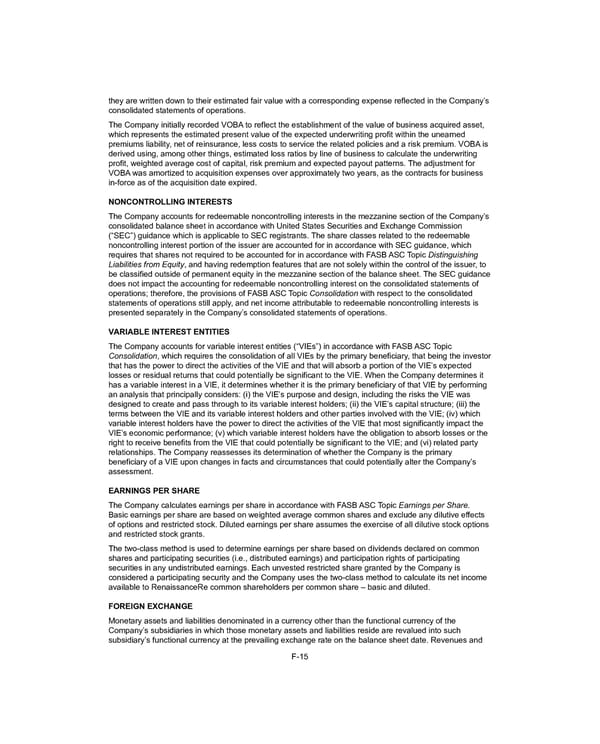they are written down to their estimated fair value with a corresponding expense reflected in the Company’s consolidated statements of operations. The Company initially recorded VOBA to reflect the establishment of the value of business acquired asset, which represents the estimated present value of the expected underwriting profit within the unearned premiums liability, net of reinsurance, less costs to service the related policies and a risk premium. VOBA is derived using, among other things, estimated loss ratios by line of business to calculate the underwriting profit, weighted average cost of capital, risk premium and expected payout patterns. The adjustment for VOBA was amortized to acquisition expenses over approximately two years, as the contracts for business in-force as of the acquisition date expired. NONCONTROLLING INTERESTS The Company accounts for redeemable noncontrolling interests in the mezzanine section of the Company’s consolidated balance sheet in accordance with United States Securities and Exchange Commission (“SEC”) guidance which is applicable to SEC registrants. The share classes related to the redeemable noncontrolling interest portion of the issuer are accounted for in accordance with SEC guidance, which requires that shares not required to be accounted for in accordance with FASB ASC Topic Distinguishing Liabilities from Equity , and having redemption features that are not solely within the control of the issuer, to be classified outside of permanent equity in the mezzanine section of the balance sheet. The SEC guidance does not impact the accounting for redeemable noncontrolling interest on the consolidated statements of operations; therefore, the provisions of FASB ASC Topic Consolidation with respect to the consolidated statements of operations still apply , and net income attributable to redeemable noncontrolling interests is presented separately in the Company’s consolidated statements of operations. VARIABLE INTEREST ENTITIES The Company accounts for variable interest entities (“VIEs”) in accordance with FASB ASC Topic Consolidation , which requires the consolidation of all VIEs by the primary beneficiary, that being the investor that has the power to direct the activities of the VIE and that will absorb a portion of the VIE’s expected losses or residual returns that could potentially be significant to the VIE. When the Company determines it has a variable interest in a VIE, it determines whether it is the primary beneficiary of that VIE by performing an analysis that principally considers: (i) the VIE’s purpose and design, including the risks the VIE was designed to create and pass through to its variable interest holders; (ii) the VIE’s capital structure; (iii) the terms between the VIE and its variable interest holders and other parties involved with the VIE; (iv) which variable interest holders have the power to direct the activities of the VIE that most significantly impact the VIE’s economic performance; (v) which variable interest holders have the obligation to absorb losses or the right to receive benefits from the VIE that could potentially be significant to the VIE; and (vi) related party relationships. The Company reassesses its determination of whether the Company is the primary beneficiary of a VIE upon changes in facts and circumstances that could potentially alter the Company’s assessment. EARNINGS PER SHARE The Company calculates earnings per share in accordance with FASB ASC Topic Earnings per Share. Basic earnings per share are based on weighted average common shares and exclude any dilutive effects of options and restricted stock. Diluted earnings per share assumes the exercise of all dilutive stock options and restricted stock grants. The two-class method is used to determine earnings per share based on dividends declared on common shares and participating securities (i.e., distributed earnings) and participation rights of participating securities in any undistributed earnings. Each unvested restricted share granted by the Company is considered a participating security and the Company uses the two-class method to calculate its net income available to RenaissanceRe common shareholders per common share – basic and diluted. FOREIGN EXCHANGE Monetary assets and liabilities denominated in a currency other than the functional currency of the Company’s subsidiaries in which those monetary assets and liabilities reside are revalued into such subsidiary’s functional currency at the prevailing exchange rate on the balance sheet date. Revenues and F-15
 2021 Annual Report Page 157 Page 159
2021 Annual Report Page 157 Page 159